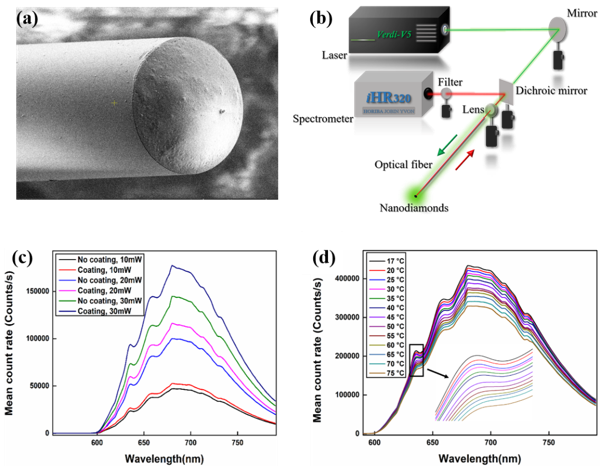In recent years, with advances in quantum physics research, quantum precision measurement technology represented by diamond nitrogen-vacancy (NV) center has rapidly developed. Thanks to its good stability, long coherence time, laser manipulation and ease of integration, the detection methods based on the NV center have attracted more and more attention. The detection based on diamond has a good perspective of application in the field of magnetic field, temperature, electric field and angular velocity sensing. In earlier studies, involving free-space optical components, conventional NV-based sensing is complex and cumbersome. Over the past few years, with the rapid development of NV center measurement technology and micro-nano processing technology, researchers have progressively stepped up their research on NV center integration. Among them, optical fiber and diamond NV center integration method attracted much attention, and optical fiber NV probes were used to measure different physical quantities. Although several fiber coupling methods have been proposed, further efforts are required to reduce the difficulty of probe fabrication and improve the efficiency fluorescence collection.
Assistant Professor Zhiqin Chu from the University of Hong Kong and Associate Professor Ruohui Wang from Northwest University (China) proposed a method of integrating nanodiamond particles and multimode optical fiber in the form of thin film in Chinese Optics Letters, Vol. 19, No. 12, 2021(C. Bian, et al., Robust integration of nitrogen-vacancy centers in nanodiamonds to optical fiber and its application in all-optical thermometry).
In the fabratcation of the optical fiber probe, the nanodiamonds particles and the UV adhesive are mixed according to a certain ratio, and the end surface of the optical fiber is uniformly coated by the pulling method to form a hemispherical film. The film is finally cured after half an hour with a UV lamp, and the nanodiamonds are firmly fixed in the optical fiber end surface. Finally, the fluorescence collection efficiency can be further improved by 22% by coated an aluminium film with a thickness of 30–50 nm on the surface of the nanodiamonds film using the magnetron sputtering method. The integration system of nitrogen-vacancy center in nanodiamonds to optical fiber, as shown in Figure 1.

Fig. 1 The integration system of nitrogen-vacancy center in nanodiamonds to optical fiber. (a) SEM image of probe; (b) Schematic diagram of experimental equipment; (c) Fluorescence intensity of the probe before and after metallization under different excitation laser powers; (d) Comparison of fluorescence signal intensity collected by the probe at different temperatures
This work also demonstrates that the variation of refractive index of UV adhesive will affect the fluorescence signal acquisition ability of optical fiber for nitrogen vacancy center, and thus can be used to measure ambient temperature. The researchers found that the decrease of refractive index of UV adhesive caused by temperature change would lead to the leakage of excitation light and fluorescence signal, that is, the different fluorescence signal intensity can reflect different external environmental temperature. And the thicker the UV adhesive film, the more obvious the thermal expansion effect. Compared with the temperature sensor based on optical detection magnetic resonance technology, the temperature information obtained by this probe using all-optical temperature measurement method is more direct and simpler. This optical fiber integrated probe based on the nanodiamonds nitrogen-vacancy center film has the advantages of small size, high sensitivity and good repeatability, and provides a solution for the integration of quantum precision measurement.


